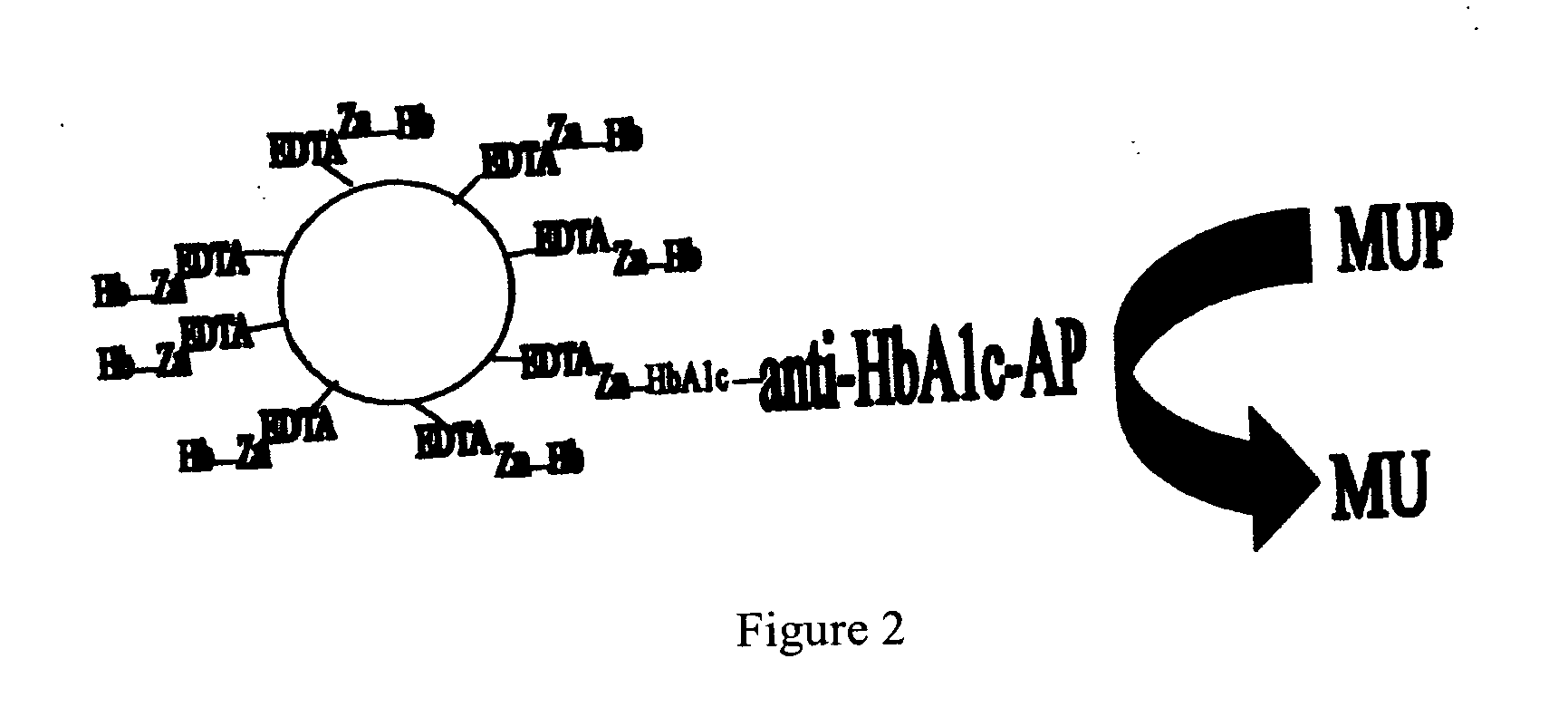Assay
a technology of assay and hba1c, applied in the field of assay methods, can solve the problems of not being accurate or easily standardized, not being easy to use, and requiring complicated procedures, and achieve the effect of improving the binding of target proteins
- Summary
- Abstract
- Description
- Claims
- Application Information
AI Technical Summary
Benefits of technology
Problems solved by technology
Method used
Image
Examples
example 1
AxSYM Automated Assay Conditions
[0114] Manually lysed blood with lysis buffer supplemented with 0.5% TX-100 and 0.8 mM zwittergent 3-14.
[0115] Pre-washed tab with MEIA+5% BSA.
[0116] Mixed lysed blood sample with equal volume zinc coated EDTA silica microparticles in 30% sucrose and incubated for 5 minutes.
[0117] Transferred to tab and washed with MEIA.
[0118] Added 1 g / ml αHbA1c in blocking buffer 17 and incubated for 5 minutes.
[0119] Washed with MEIA.
[0120] Added α-mouse-alkaline phosphatase diluted 1 in 3000 with HEPES pH7.
[0121] Washed with MEIA.
[0122] Added MUP and read.
TABLE 1SampleBlankRateRatio1 mg / ml Hb1753121:1.8RBC (5% HbA1c)2113711:1.8RBC (9% HbA1c)2115311:2.5
[0123] The assay detected presence of HbA1c and discriminated between 5% and 9% HbA1c levels.
example 2
IMx Automated Assay Conditions
[0124] Pre-washed tab with MEIA+5% BSA.
[0125] Mixed sample and 0.1% zinc coated EDTA silica microparticles in 30% sucrose (1:1).
[0126] Applied to tab and washed with MEIA (2×50 μl).
[0127] Added 1 μg / ml αHbA1c in HEPES and incubated for 5 min.
[0128] Washed with MEIA (2×50 μl).
[0129] Added α-mouse-alkaline phosphatase conjugated (diluted 1 in 3000 with HEPES) and incubated for 5 min.
[0130] Washed with MEIA (2×50 μl).
[0131] Added MUP and read.
TABLE 2SampleRateParticles (blank)97HbA1c (0.25 mg)330Hb (0.125 mg) + HbA1c (0.125 mg)175Hb (0.2 mg) + HbA1c (0.05 mg)132Hb (0.25 mg)121
[0132] Increasing the concentrations of HbA1c resulted in higher rates measured.
example 3
96 Well Vacuum Manifold Assay
Capturing Hb Using Zn Microparticles
[0133] Silica EDTA and polystyrene NTA microparticles were coated with ZnCl2 and incubated at 0.5% solids with Hb (0.5 mg / ml) or (0.2 mg / ml) for 10 min. Binding was assessed by measuring the unbound material using OD 405 nm. The readings for 0.5 mg / ml and 0.2 mg / ml fell within the linear range for Hb measurement at 405 nm.
TABLE 3Binding capacity of zinc coated silica EDTA and polystyreneNTA microparticles for hemoglobin.MeasuredunboundMeasured0.5 mg / ml HbunboundAverage0.1 mg / ml HbOD 405 nmAverage OD(minusBound405 nm (minusBoundbackground)(%)background)(%)polystyrene NTA0.249700.02484Silica EDTA 1.5 μm0.118860100(1st batch)Silica EDTA 1.0 μm0.093890100Silica EDTA 1.5 μm0.111870100(2nd batch)Silica EDTA 3.0 μm0.273670.03775Input Hb 0.5 mg / ml0.828Input Hb 0.1 mg / ml0.146
[0134] This experiment showed that the silica EDTA beads of 1-1.5 μm displayed the highest binding capacity (over 85% for 0.5 mg / ml HIb and 100% for ...
PUM
 Login to View More
Login to View More Abstract
Description
Claims
Application Information
 Login to View More
Login to View More - R&D
- Intellectual Property
- Life Sciences
- Materials
- Tech Scout
- Unparalleled Data Quality
- Higher Quality Content
- 60% Fewer Hallucinations
Browse by: Latest US Patents, China's latest patents, Technical Efficacy Thesaurus, Application Domain, Technology Topic, Popular Technical Reports.
© 2025 PatSnap. All rights reserved.Legal|Privacy policy|Modern Slavery Act Transparency Statement|Sitemap|About US| Contact US: help@patsnap.com


